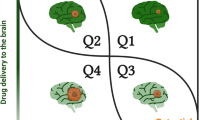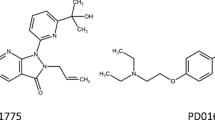Summary
A pharmacokinetic [PK]-driven screening process was implemented to select new agents for brain tumor chemotherapy from a series of low molecular weight anticancer agents [ON27x] that consisted of 141 compounds. The screening procedures involved a combination of in silico, in vitro and in vivo mouse studies that were cast into a pipeline of tier 1 and tier 2 failures that resulted in a final investigation of 2 analogues in brain tumor-bearing mice. Tier 1 failures included agents with a molecular weight of > 450 Da, a predicted log P (log P) of either <2 or > 3.5, and a cytotoxicity IC50 value of > 2 uM. Next, 18 compounds underwent cassette dosing studies in normal mice that identified compounds with high systemic clearance, and low blood–brain barrier [BBB] penetration. These indices along with a derived parameter, referred to as the brain exposure index, comprised tier 2 failures that led to the administration of 2 compounds [ON27570, ON27740] as single agents [discrete dosing] to mice bearing intracerebral tumors. Comparison of ON27570’s resultant PK parameters to those obtained in the cassette dosing format suggested a drug-drug interaction most likely at the level of BBB transport, and prompted the use of the in vitro MDCK-MDR1 transport model to help assess the nature of the discrepancy. Overall, the approach was able to identify candidate compounds with suitable PK characteristics yet further revisions to the method, such as the use of in vitro metabolism and transport assays, may improve the PK-directed approach to identify efficacious agents for brain tumor chemotherapy.


Similar content being viewed by others
References
Challenges and Opportunities Report (CDER) (2004) Innovation and stagnation: Challenge and opportunity on the critical path to new medicinal products. US Food and Drug Administration
Zerhouni E (2003) Medicine. The NIH Roadmap. Science 302:63–72
Wang S, Guo P, Wang X, Zhou Q, Gallo JM (2008) Preclinical pharmacokinetic/pharmacodynamic models of gefitinib and the design of equivalent dosing regimens in EGFR wild-type and mutant tumor models. Mol Cancer Ther 7:407–417
Wang S, Zhou Q, Gallo JM (2009) Demonstration of the equivalent pharmacokinetic/pharmacodynamic dosing strategy in a multiple-dose study of gefitinib. Mol Cancer Ther 8:1438–1447
He K, Qian M, Wong H, Bai SA, He B, Brogdon B et al (2008) N-in-1 dosing pharmacokinetics in drug discovery: experience, theoretical and practical considerations. J Pharm Sci 97:2568–2580
Smith NF, Raynaud FI, Workman P (2007) The application of cassette dosing for pharmacokinetic screening in small-molecule cancer drug discovery. Mol Cancer Ther 6:428–440
Tamvakopoulos CS, Colwell LF, Barakat K, Fenyk-Melody J, Griffin PR, Nargund R et al (2000) Determination of brain and plasma drug concentrations by liquid chromatography/tandem mass spectrometry. Rapid Commun Mass Spectrom 14:1729–1735
Zhang MY, Kerns E, McConnell O, Sonnenberg-Reines J, Zaleska MM, Steven Jacobsen J et al (2004) Brain and plasma exposure profiling in early drug discovery using cassette administration and fast liquid chromatography-tandem mass spectrometry. J Pharm Biomed Anal 34:359–368
Hegi ME, Diserens AC, Bady P, Kamoshima Y, Kouwenhoven MC, Delorenzi M et al (2011) Pathway analysis of glioblastoma tissue after preoperative treatment with the EGFR tyrosine kinase inhibitor gefitinib–a phase II trial. Mol Cancer Ther 10:1102–1112
Heon S, Yeap BY, Britt GJ, Costa DB, Rabin MS, Jackman DM et al (2010) Development of central nervous system metastases in patients with advanced non-small cell lung cancer and somatic EGFR mutations treated with gefitinib or erlotinib. Clin Cancer Res 16:5873–5882
Geyer JR, Stewart CF, Kocak M, Broniscer A, Phillips P, Douglas JG (2010) A phase I and biology study of gefitinib and radiation in children with newly diagnosed brain stem gliomas or supratentorial malignant gliomas. Eur J Cancer 46:3287–3293
McKillop D, McCormick AD, Millar A, Miles GS, Phillips PJ, Hutchison M (2005) Cytochrome P450-dependent metabolism of gefitinib. Xenobiotica 35:39–50
Lemos C, Kathmann I, Giovannetti E, Calhau C, Jansen G, Peters GJ (2009) Impact of cellular folate status and epidermal growth factor receptor expression on BCRP/ABCG2-mediated resistance to gefitinib and erlotinib. Br J Cancer 100:1120–1127
Kawamura K, Yamasaki T, Yui J, Hatori A, Konno F, Kumata K et al (2009) In vivo evaluation of P-glycoprotein and breast cancer resistance protein modulation in the brain using [(11)C]gefitinib. Nucl Med Biol 36:239–246
Watanabe T, Schulz D, Morisseau C, Hammock BD (2006) High-throughput pharmacokinetic method: cassette dosing in mice associated with minuscule serial bleedings and LC/MS/MS analysis. Anal Chim Acta 559:37–44
Smith NF, Hayes A, Nutley BP, Raynaud FI, Workman P (2006) Evaluation of the cassette dosing approach for assessing the pharmacokinetics of geldanamycin analogues in mice. Cancer Chemother Pharmacol 54:475–486
Zhou Q, Gallo JM (2009) Differential effect of sunitinib on the distribution of temozolomide in an orthotopic glioma model. Neuro Oncol 11:301–310
Boudinot FD, Jusko WJ (1984) Fluid shifts and other factors affecting plasma protein binding of prednisolone by equilibrium dialysis. J Pharm Sci 73:774–780
Luo S, Kansara VS, Zhu X, Mandava NK, Pal D, Mitra AK (2006) Functional characterization of sodium-dependent multivitamin transporter in MDCK-MDR1 cells and its utilization as a target for drug delivery. Mol Pharm 3:329–339
Soldner A, Benet LZ, Mutschler E, Christians U (2000) Active transport of the angiotensin-II antagonist losartan and its main metabolite EXP 3174 across MDCK-MDR1 and caco-2 cell monolayers. Br J Pharmacol 129:1235–1243
Wang Q, Rager JD, Weinstein K, Kardos PS, Dobson GL, Li J et al (2005) Evaluation of the MDR-MDCK cell line as a permeability screen for the blood–brain barrier. Int J Pharm 288:349–359
van de Waterbeemd H, Gifford E (2003) ADMET in silico modelling: towards prediction paradise? Nat Rev Drug Discov 2:192–204
Waterhouse RN (2003) Determination of lipophilicity and its use as a predictor of blood–brain barrier penetration of molecular imaging agents. Mol Imaging Biol 5:376–389
Levin VA (1980) Relationship of octanol/water partition coefficient and molecular weight to rat brain capillary permeability. J Med Chem 23:682–684
Agarwal S, Sane R, Gallardo JL, Ohlfest JR, Elmquist WF (2010) Distribution of gefitinib to the brain is limited by P-glycoprotein (ABCB1) and breast cancer resistance protein (ABCG2)-mediated active efflux. J Pharmacol Exp Ther 334:147–155
Hofer S, Frei K, Rutz HP (2006) Gefitinib accumulation in glioblastoma tissue. Cancer Biol Ther 5:483–484
Ozvegy-Laczka C, Hegedus T, Várady G, Ujhelly O, Schuetz JD, Váradi A et al (2004) High-affinity interaction of tyrosine kinase inhibitors with the ABCG2 multidrug transporter. Mol Pharmacol 65:1485–1495
Carcaboso AM, Elmeliegy MA, Shen J, Juel SJ, Zhang ZM, Calabrese C et al (2010) Tyrosine kinase inhibitor gefitinib enhances topotecan penetration of gliomas. Cancer Res 70:4499–4508
Nagilla R, Nord M, McAtee JJ, Jolivette LJ (2011) Cassette dosing for pharmacokinetic screening in drug discovery: comparison of clearance, volume of distribution, half-life, mean residence time, and oral bioavailability obtained by cassette and discrete dosing in rats. J Pharm Sci 100:3862–3874
Li J, Brahmer J, Messersmith W, Hidalgo M, Baker SD (2006) Binding of gefitinib, an inhibitor of epidermal growth factor receptor-tyrosine kinase, to plasma proteins and blood cells: in vitro and in cancer patients. Invest New Drugs 24:291–297
McKillop D, Hutchison M, Partridge EA, Bushby N, Cooper CM, Clarkson-Jones JA et al (2004) Metabolic disposition of gefitinib, an epidermal growth factor receptor tyrosine kinase inhibitor, in rat, dog and man. Xenobiotica 34:917–934
Kerns EH (2001) High throughput physicochemical profiling for drug discovery. J Pharm Sci 90:1838–1858
Hop CE, Cole MJ, Davidson RE, Duignan DB, Federico J, Janiszewski JS et al (2008) High throughput ADME screening: practical considerations, impact on the portfolio and enabler of in silico ADME models. Curr Drug Metab 9:847–853
Carlson TJ, Fisher MB (2008) Recent advances in high throughput screening for ADME properties. Comb Chem High Throughput Screen 11:258–264
Ebinger M, Uhr M (2006) ABC drug transporter at the blood–brain barrier: effects on drug metabolism and drug response. Eur Arch Psychiatry Clin Neurosci 256:294–298
Tamai I, Tsuji A (2000) Transporter-mediated permeation of drugs across the blood–brain barrier. J Pharm Sci 89:1371–1388
Wan H, Rehngren M, Giordanetto F, Bergström F, Tunek A (2007) High-throughput screening of drug-brain tissue binding and in silico prediction for assessment of central nervous system drug delivery. J Med Chem 50:4606–4615
Hammarlund-Udenaes M, Fridén M, Syvänen S, Gupta A (2008) On the rate and extent of drug delivery to the brain. Pharm Res 25:1737–1750
Taub ME, Podila L, Ely D, Almeida I (2005) Functional assessment of multiple P-glycoprotein (P-gp) probe substrates: influence of cell line and modulator concentration on P-gp activity. Drug Metab Dispos 33:1679–1687
Acknowledgements
This work was supported by grants CA127963 and CA127963-S1 from the NIH.
Conflict of interest
Dr. E.P. Reddy is the scientific founder, stock holder, board member and paid consultant of Onconova Therapeutics Inc. He is also one of the inventors of the patents that describe the compounds described here.
Author information
Authors and Affiliations
Corresponding author
Electronic supplementary material
Below is the link to the electronic supplementary material.
ESM 1
(DOC 151 kb)
Rights and permissions
About this article
Cite this article
Lv, H., Wang, F., Reddy, M.V.R. et al. Screening candidate anticancer drugs for brain tumor chemotherapy: Pharmacokinetic-driven approach for a series of (E)-N-(substituted aryl)-3-(substituted phenyl)propenamide analogues. Invest New Drugs 30, 2263–2273 (2012). https://doi.org/10.1007/s10637-012-9806-x
Received:
Accepted:
Published:
Issue Date:
DOI: https://doi.org/10.1007/s10637-012-9806-x




